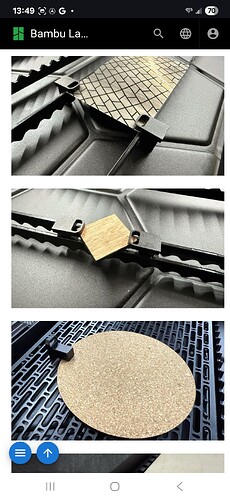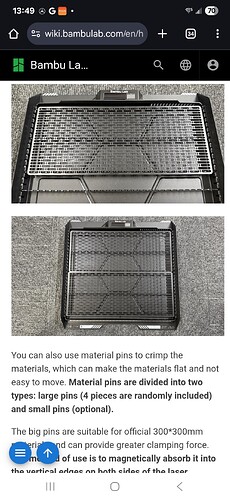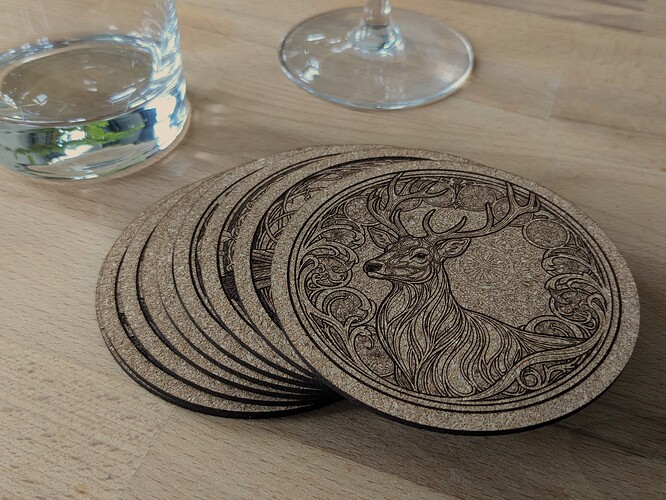I see a lot of people that actually do not like the laser idea for the H2D and I can see the reasons for their worries. That being said I am still looking to maybe get one, can anyone who has a 10W or even a 40W tell me what the experience is? How is cleanup, how loud is it, how good does it work? Looking to maybe get a 10W so if anyone has that one please give me some of the things you have experienced good and bad.
I have the 40w laser. I’ve engraved a few dog tags and engraved and cut a fair bit of plywood. Engraving metal is pretty clean and painless where cutting wood produces a lot of smoke and leaves some residue behind. The unit does a great job of expelling the smoke but the cut material and residue of course smell like burnt wood.
Cleanup is easy enough with alcohol and lint-free cloth. Just follow the bambu cleanup guide. After cleanup the smell will dissipate pretty quickly but otherwise it will linger for a few days. Just make sure to do regular cleaning and maintenance. I think they say monthly but if you’re cutting a lot then shorten that.
Overall it works great. Bambu has done a really good job of holding your hand through the process of getting started through the software and even requires you to watch a safety video before you use it the first time. There are sensors everywhere to make sure you have it setup correctly and safely. Bambusuite isn’t as polished as their Slicer and I think the material detection feature has only worked once.
The fear mongering over the laser is too much. If you’re buying it as a printer with occasional laser use it’s well suited for that.
If you don’t mind a question, I bought the 40w variant too, but have only printed so far and have all of the attachments boxed. I plan to try it out over the summer when I have more time. I only see myself using the laser occasionally. Do you think the air filtration add on is necessary? I’d really rather not spend another $600 after the huge initial cost. But I’m not sure how necessary it is and if it’s intended more for the quanitty the laser is used or hazard of certain material types. How is yours set up and what are your thoughts?
I have the 40w laser, it is absolutely amazing and the h2d actually gets rid of the smell and smoke extremely well. I do reccomend though that after lasering, just do a quick wipe down and then turn on the exhaust to 100% for around 10-15 minutes and all the smells should be gone. Or atleast that’s what worked for me. I got rid of that burnt smell. I posted on Reddit a photo of one of the lasering things I did.
Honestly, just vent it out the window, if your lasering inside, no venting out the window, get filtration please and even then be careful of what you cut cause it doesn’t filter carbon monoxide or radon/radium ( don’t remember )
If you are only using it occasionally I would recommend getting an adjustable inline fan on amazon and running it out the window for the rare times you use it. It will be much cheaper. You will definitely want something to extract the air better with plastics.
Aside from the fact that flammable materials generate significant amounts of smoke, many things you can put in a laser cutter produce outright toxic gasses. That can include otherwise innocuous materials like MDF or plywood (the adhesives are the problem, most common types produce Formaldehyde). You absolutely must vent a laser cutter outdoors if you don’t have a filter specifically designed so that you don’t have to vent it outdoors. Those indoor filters are expensive and need replacing all the time (assuming you’re lasing frequently). So just venting it through a 4" dryer duct out the window can be a lot less expensive. Except… where you live matters. If you’re in an apartment building, or something like row-housing, venting out your window means you’re exposing your neighbors to the toxic gasses. In which case, you really should get a filter or only laze when it’s cold and rainy and everyone’s windows will be closed. ![]()
I connect the printer directly to a 4 inch duct vent in the room that I also use for my paint booth. You could accomplish the same thing by exhausting out of a window though. They also sell window vent kits on Amazon that will close the gap in the window to keep the fumes from blowing back in if you need it. I used the AC infinity window vent kit for painting before I installed the duct vent in the wall.
The filter would only be necessary if you can’t vent it out of a window. I would recommend just running the exhaust tubing directly out of a window. Adding an inline fan could cause problems if it’s not as strong or stronger than the fan that’s in the printer.
Got it, so far have not used it or the cutter.
Why then?
Well I’ve got very limited space and do not have room for either a dedicated laser or a cutter. I can see me using both but have not run a project so far that needs them - mostly as I’m still very much printing stuff for 3D printing solutions (dry box mods, poop chute, air filters) and stuff that I had planned pre-printer (custom watch crystal storage drawers to fit Ikea Besta units).
Already plumbed in external extraction and fan so this isn’t an issue for me.
The green door and windows are annoying though, absolute dust magnets and you really can’t see in there very well. I know that’s exactly the point but I am tempted to get the glass door and then refit the green laser door when I need to use it.
Me too, haven’t used it yet. Too busy printing stuff, but I plan to engrave in the very near future. I didn’t want to have to go through the hassle of upgrading it later, so I just got the 10w combo.
I have the 10W laser, and so far I have been using it for engraving stainless steel, anodized aluminum and some of my tools. In total approximately 15hrs of engraving.
So far no cleaning required.
I had one time an issue where I constantly got fire alarms, but that was caused by a disc that was curling up because of the heat and the laser got out of focus. Probably the fire sensor in the tool head triggered this.
It was all stainless steel so no fire hazard there.
Done successful jobs after that so no damage to the laser or printer.
I don’t intend to do a lot of cutting and specifically no plastics. That causes a lot of dirt inside the printer.
Have not used the cutting/plotter module yet. But some projects are in the making for this.
I have the 40W version and the air purifier arrived, so I finally got to to test the laser yesterday. The Bambu Suite software is easy to use and has some really powerful features, once you get familiar with it. Rather than do a demo project, my first cuts were my own designs. I designed a set of nature-themed art nouveau drink coasters. They came out fantastic, I am really happy with the laser overall, can’t recommend it enough, for people who only cut occasionally!
If you are interested in the coasters, I just put the project on maker world here.
Having a big CO2 laser, I have experience with the smells, the residues, etc. Some tips. DON’T cut Acrylics in it unless you have a means to really clean the residue off the grids. The gasses build up on the grid, especially if you use honey comb, though the provided slats one can also build up, and that residue is flammable. Many a person has lost their laser by not cleaning the residue out when doing a lot of Acrylic work, including etching.
Do NOT, repeat DO NOT cut PVC in this little thing, PVC emits deadly chlorine gasses when cut and the extractor may not be strong enough to eliminate the gas. My laser uses a strong greenhouse extractor and no filters to restrict to pull the vapors out and away, however the gas can build up around the base of the vent on a calm day and leak back in when turned off depending on where you locate the machine. If in a basement, I would not cut PVC, period.
Depending on the number of layers, some plywoods, like 5 ply birch, don’t cut well and may actually start on fire instead. The adhesive between the layers, as mentioned above, can reflect the energy back into the upper layers instead of being burned through, so be very careful and WATCH the cutting when doing plywoods. Wear Laser glasses too, they make safety glasses that protect against the wavelengths of the Diode laser. Make sure they are DIODE and not CO2 as they are on different wavelengths. The panels are laser proof, but sometimes you may need to open the door when cutting to inspect the work in progress.
I don’t know if I will ever use the 40w laser, but nice to have in a pinch. Just be careful and keep it clean.


